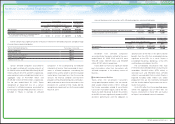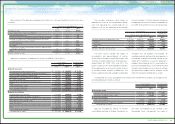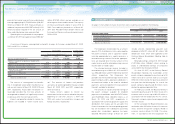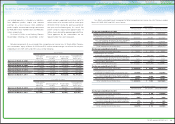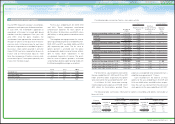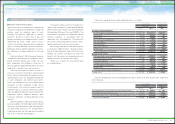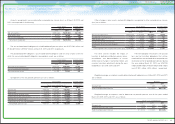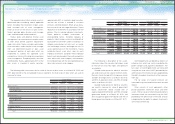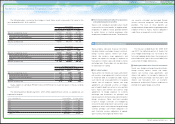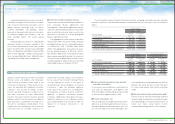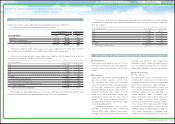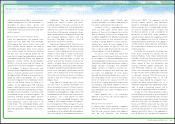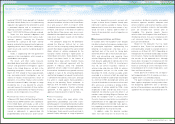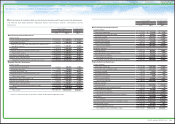Toyota 2011 Annual Report Download - page 95
Download and view the complete annual report
Please find page 95 of the 2011 Toyota annual report below. You can navigate through the pages in the report by either clicking on the pages listed below, or by using the keyword search tool below to find specific information within the annual report.
Derivative financial instruments:
20
0822
Financial Section and
Investor Information
Business and
Performance Review
Special FeatureMessage/Vision
Management and
Corporate Information
Notes to Consolidated Financial Statements
The following tables summarize the changes in Level 3 plan assets measured at fair value for the
years ended March 31, 2010 and 2011:
Toyota expects to contribute ¥97,231 million ($1,169 million) to its pension plans in the year ending
March 31, 2012.
The following pension benefit payments, which reflect expected future service, as appropriate, are
expected to be paid:
Yen in millions
For the year ended March 31, 2010
Debt securities
Other Total
Balance at beginning of year ¥ 5,242 ¥45,825 ¥51,067
Actual return on plan assets 818 (2,206) (1,388)
Purchases, sales and settlements (2,233) 3,467 1,234
Other (236) (568) (804)
Balance at end of year ¥ 3,591 ¥46,518 ¥50,109
Yen in millions
For the year ended March 31, 2011
Debt securities
Other Total
Balance at beginning of year ¥ 3,591 ¥46,518 ¥50,109
Actual return on plan assets 312 1,908 2,220
Purchases, sales and settlements (2,948) 11,490 8,542
Other (209) (1,065) (1,274)
Balance at end of year ¥ 746 ¥58,851 ¥59,597
U.S. dollars in millions
For the year ended March 31, 2011
Debt securities
Other Total
Balance at beginning of year $ 43 $560 $603
Actual return on plan assets 4 23 27
Purchases, sales and settlements (35) 138 103
Other (3) (13) (16)
Balance at end of year $ 9 $708 $717
Years ending March 31, Yen in millions
U.S. dollars in millions
2012 ¥ 72,170 $ 868
2013 71,235 857
2014 73,345 882
2015 76,567 921
2016 79,591 957
from 2017 to 2021 442,737 5,324
Total ¥815,645 $9,809
Toyota’s U.S. subsidiaries provide certain health
care and life insurance benefits to eligible retired
employees. In addition, Toyota provides benefits
to certain former or inactive employees after
employment, but before retirement. These benefits
are currently unfunded and provided through
various insurance companies and health care
providers. The costs of these benefits are
recognized over the period the employee provides
credited service to Toyota. Toyota’s obligations
under these arrangements are not material.
Postretirement benefits other than pensions
and postemployment benefits
Toyota employs derivative financial instruments,
including foreign exchange forward contracts,
foreign currency options, interest rate swaps,
interest rate currency swap agreements and
interest rate options to manage its exposure to
fluctuations in interest rates and foreign currency
exchange rates. Toyota does not use derivatives
for speculation or trading.
Toyota enters into interest rate swaps and interest
rate currency swap agreements mainly to convert
its fixed-rate debt to variable-rate debt. Toyota
uses interest rate swap agreements in managing
interest rate risk exposure. Interest rate swap
agreements are executed as either an integral
part of specific debt transactions or on a portfolio
basis. Toyota uses interest rate currency swap
agreements to hedge exposure to currency
exchange rate fluctuations on principal and
interest payments for borrowings denominated in
foreign currencies. Notes and loans payable
issued in foreign currencies are hedged by
concurrently executing interest rate currency swap
agreements, which involve the exchange of foreign
currency principal and interest obligations for
each functional currency obligations at agreed-
upon currency exchange and interest rates.
For the years ended March 31, 2009, 2010
and 2011, the ineffective portion of Toyota’s fair
value hedge relationships was not material. For
fair value hedging relationships, the components
of each derivative’s gain or loss are included in the
assessment of hedge effectiveness.
Toyota uses foreign exchange forward contracts,
foreign currency options, interest rate swaps,
interest rate currency swap agreements, and
interest rate options, to manage its exposure to
foreign currency exchange rate fluctuations and
interest rate fluctuations from an economic
perspective, and for which Toyota is unable or has
elected not to apply hedge accounting.
Fair value hedges
Undesignated derivative financial instruments
95TOYOTA ANNUAL REPORT 2011


